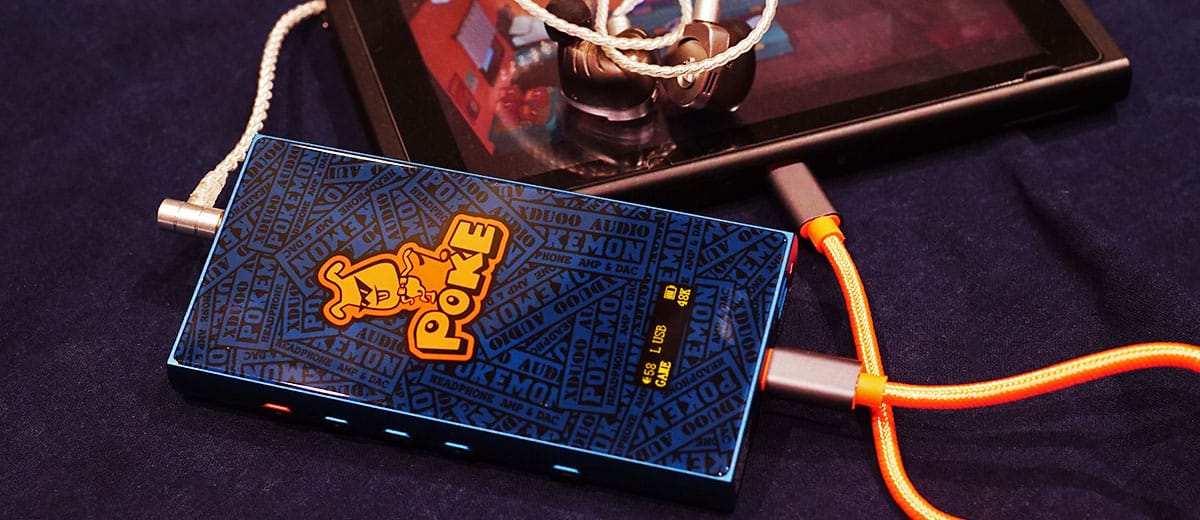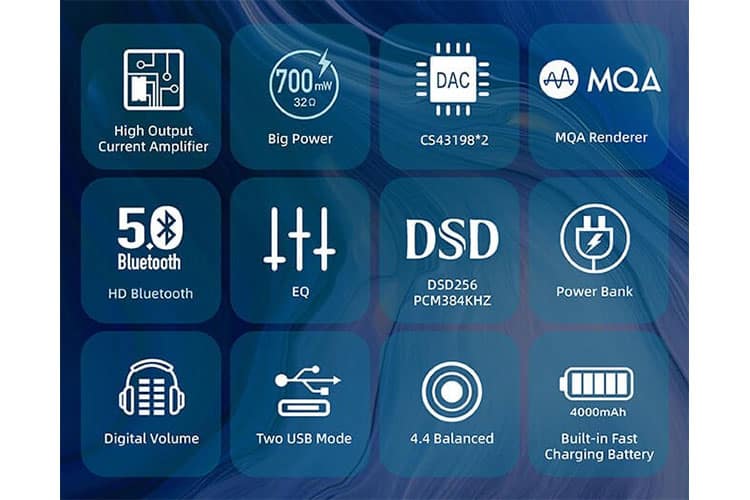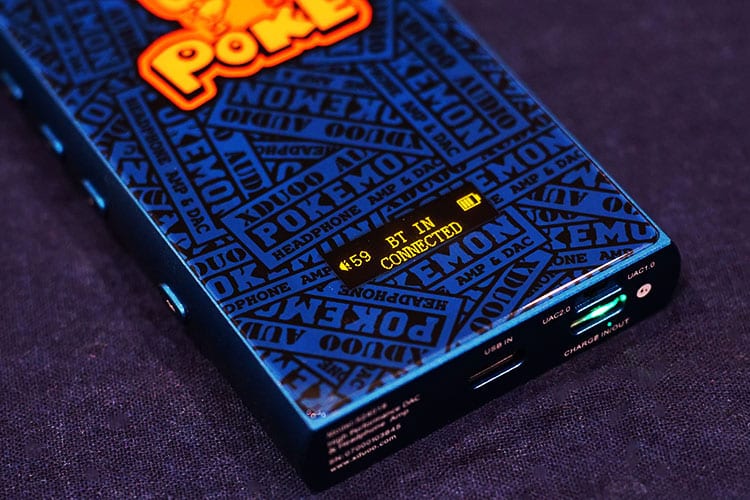Our review today covers the new xDuoo Poke II which is an integrated portable DAC and high output current amplifier with a bold youthful design. It is priced at $390.
Disclaimer: This is a sample sent in exchange for our honest opinion. Headfonics is an independent website with no affiliate links or status. Thank you to xDuoo for this opportunity.
Click here to read more on xDuoo products that we have previously covered on Headfonics
Note, that this article follows our latest scoring guidelines which you can read up on here.
The xDuoo Poke II is the company’s latest portable DAC and Bluetooth amplifier. It stands out in the product lineup from more sedately finished alternatives such as the XD05 with a high contrast POP/ graffiti style theme.
Its name is also the short form of Pokémon which, combined with the striking decals, seems to be a direct pitch to a more youthful audiophile profile.
This is also quite a powerful portable integrated DAC/amp with a handful of interesting features for what seems to be a fairly reasonable asking price of $390.
Tech Highlights
The Poke II uses a balanced amplification topology capable of outputting as much as 700mW via its 4.4mm PO.
This is also a high current output amp architecture meaning that it is especially geared to handling IEMs and planar headphones with high current demand. The SNR goes as high as 119dB and the THD+N performance reaches 0.0015%.
The DAC inside is a dual Cirrus Logic CS43198 capable of decoding up to DSD256 natively and PCM384kHz, also supporting MQA unfolding up to 8x when used as a USB DAC.
The Polk 2 also supports Bluetooth wireless connectivity with up to LDAC and aptX HD decoding rates.
As claimed by xDuoo the Poke II is designed to support a wide range of devices with switchable UAC standards. This allows it to be connected with Nintendo switch and many other devices that rely on the older USB connection protocol.
Internal Hardware
The internal hardware symmetrically placed on Poke II’s motherboard is consist of CSR8675 Bluetooth chipsets, XMOS USB solution, a power regulating circuit, switching circuit volume chipsets NJW1194E, AD8397 BUF, and a protection circuit to not let sudden swings or DC damage earphones in the output while enabling high output power.
Performance Numbers
With an LDO power supply design with high PSRR measured, the Poke II achieves a 119dB S/N ratio and 0.0019% in THD+N.
With a 32Ω load, the Poke II is able to offer 340mW in SE output and 700mW with balanced output and could power various IEMs and small cans sufficiently loud and free from noise.
The output power on 4.4mm output is quite high and comparable to some mid-end DAPs, while the S/N ratio and noise performance are fairly good for the price.
Design
The Poke II has an Aluminum frame that feels very light in the hand and can fit on the back of most DAPs or phones without being too unwieldy. Unlike most audiophile-targeted items, the Poke II looks stylish and colorful, and also very friendly in the way it arranges the buttons.
On the front side of the Poke II, we can see a cheeky version Pokémon-styled mascot, underneath on the bottom side there is a small screen that displays settings and connection statuses. Flipping to the back in the same graffiti style the sentence “Life’s a struggle” is painted… and yeah it’s pretty bold looking. No mistaking the target market here.
On the metallic body, there are 8 buttons, 2 output jacks, two USB ports, and a UAC switch. The physical controls make life a lot easier for those who don’t want to navigate through settings on a tiny display. On the side, we have Bluetooth connection, volume, on/off, and EQ buttons. On the top, there are 3 buttons namely gain, filter, and input.
Users can press the gain button for a 6dB max boost, and switch between 2 digital filters with a range of equalizers. Everything is self-explanatory here and no user manual is needed, with an instant effect.
There is one other unusual feature which is a microphone on the bottom corner, allowing the Poke II to be used for video conferencing or team speaking in games.
I/O
On top of the Poke II, there is a 3.5mm and a 4.4mm output, where the balanced 4.4mm connection fully utilizes the dual DAC’s capability and power to output a maximum of 700mW @32Ω.
Flipping to the bottom of the device there are two USB-C jacks that allow users to connect to a USB source while charging, or to charge another USB device using the Poke II as a charging bank.
The UAC 1.0 and 2.0 toggle allows users to pair with devices like the Nintendo Switch on a USB connection, so you could enjoy high-quality gameplay BGM/ SFX on the go.
Packaging & Accessories
The packaging is in sync with the design theme of the Poke II, and the print quality is decent. Taking off the sleeves the inner box packs in two Type-C cables designed for lightning iOS devices and Android USB-C terminated devices, plus a USB-A converter to connect to laptops.
The multiple USB cablings that tag along hint that the Poke II is designed not only for Bluetooth Connection but also for a USB connection that normally yields better quality. There is also a jelly pad for those who want to stick the amplifier and decoder behind devices.
There is also an orange USB cable that aligns with the POKE logo so plenty of welcome attention seems to be going into the accessory line-up
Battery
Inside the Poke II resides a 4000mAh battery and users could charge phones or other gears with the USB-C output.
From official data, the battery supports 12 hours of playback in Bluetooth mode and lasts more than 8 hours with a USB connection. It is also claimed that the battery supports fast charging. With the presence of 2 USB-C ports, you can charge while listening to the Poke II.
Wireless Connectivity
Bluetooth
Poke II supports LDAC and aptX HD codecs, under LDAC connection the quality is superior but when streaming videos, you may feel a small bit of latency.
The receiving range is average when moving around you will hear signal drops intermittingly, but for a normal usage scenario in the pocket or stuck to the back of the phone it connects stably and doesn’t pick up much interference from the phone when a call comes in.
Wired Connectivity
USB-DAC
The Poke II can be connected to iOS lightning devices and phones via its USB-C port and for Windows users, the driver has to be downloaded from the main website support section.
The performance of the USB connection is superior to the Bluetooth connection and is preferred whenever USB linkage is possible.
Sound Impressions
Summary
The sound impression below is based on the superior USB connection, with the Poke II burnt in for roughly 100 hours. LDAC connection yields similar results but with a USB connection, the output is more natural and more dynamic to my ears.
The tuning on the Poke II is clean and slightly soft in the low end, aligning with what I experience on quite some other designs based on the 43198 such as the L&P W2, but the Poke II is definitely stronger in the output and sounds more expansive.
Bass
The sub-bass kicks moderately deep on the Poke II and renders the bass quite deep and strong. You can feel the rumble as well as decent texture in the bass. The bass doesn’t bleed all over and is free from colorings as it is not thickened.
Listening to jazz and pop you can hear the bass being quite responsive, with a rather fast attack and clean decay that follows. As such the dynamics in the lower register are quite strong favoring pops and blues which would sound very rhythmic and swiftly flowing.
The upper bass is clean and not colored as well, and it renders more space between the listener and the vocal. It doesn’t mean that the upper bass or lower mid-bass range is recessed, but just smoothly presented to enhance the overall balance without covering the details on the two ends of the frequency spectrum.
Mids
While the mids aren’t very strong in intensity, it is smoothly rendered and stereophonically shaped. This aligns with my previous experience with various devices using the Cirrus Logic chipsets, which are able to output clean, uncolored yet 3D vocals.
If more mid-bass is preferred the on-board filters could add a bit more weight to the lower vocal frequencies, which could color the output more engaging.
To my ears, the tuning favors female vocalists more, as the lower mids are on the light side and more texture would be preferred for powerful, masculine voices. Lighter female vocalists, in contrast, sound sweet and polished on the Poke II, while mid-range instruments are cleanly presented and well defined as well with adequate sharpness and presence.
Treble
The upper frequencies could be the weaker link with Bluetooth amplifiers that are sometimes losing control or feeling not defined. On the Poke II, the tuning is doing well in presenting the edges of the sharper instruments but not letting it go over the threshold to sound harsh.
There is decent texture and power even with small cans, which sounds comparatively much lossier on the phone’s output.
When powering with dynamic IEMs and earbuds there is good openness, as a result of the much higher output power than on laptop or phone outputs.
On higher gain, the upper mids to the treble range is pushed slightly more forwarded and you could hear more air captured as well as enhanced texture and firmness in the upper register.
Staging & Dynamics
The Poke II is tuned to be slightly V-shaped and stresses the two ends, so it sounds expansive and boosts the dynamics. Although the vocal image is spaced out slightly from the listener, good depth is rendered and a holographic image is preserved.
Vocal and acoustic instruments have decent separation from the backing track without blurring into the background
Transients, on the other hand, have an adequate presence on both ends of the frequencies but aren’t overly emphasized. Instead of stressing the resolution, the Poke II seems to focus on boosting dynamics and openness in sound.
The easy-going and swift character works well for pops and streaming content, also rocks and live music as well when you boost the bass a bit with EQ or the filters.







